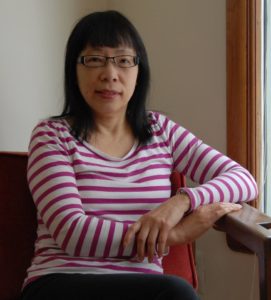 Laura Joh Rowland wrote the long running, beloved Sano Ichiro series set in feudal Japan. She has also written mysteries featuring Charlotte Bronte, and now is writing a series set in 1888 London featuring photographer Sarah Bain. In the first of the series, The Ripper’s Shadow, Sarah ends up in the crosshairs of both the police and the Ripper himself.
Laura Joh Rowland wrote the long running, beloved Sano Ichiro series set in feudal Japan. She has also written mysteries featuring Charlotte Bronte, and now is writing a series set in 1888 London featuring photographer Sarah Bain. In the first of the series, The Ripper’s Shadow, Sarah ends up in the crosshairs of both the police and the Ripper himself.
Q: Your first series, set in feudal Japan, was always really popular with our customers, and I wonder how you picked that particular time period?
A:The short answer is, I watched too many samurai movies while I was in college (at the University of Michigan. Go Blue!). The longer answer is that when I decided to write mystery novels, I needed to carve out a territory for myself, and feudal Japan was wide open. It was a marriage of interest and opportunity.
Q: I often think historical mystery writers are the most “pure” detective novelists working at the moment, as they aren’t using all the new forensic tools available to contemporary detectives, they have to use good old fashioned shoe leather and deductive reasoning to solve the crime. What are your thoughts on that?
A: I agree. Modern forensic tools are amazing, but even nowadays they don’t always solve cases. It often comes down to what a jury believes. I was a scientist when I started writing fiction, and I chose historical novels partly because I wouldn’t have to write about the scientific instruments and techniques I used at my day job.
Q: You now have had quite a long career, with an impressive number of books, all of them in the historical mystery genre. What drew you to historicals? Are you trained as an historian?
A: I’m not trained as an historian, but I love tracking down information. There’s no thrill quite like finding a fact that I need for a story. It’s like a treasure hunt. I like historical novels because they’re a welcome break from modern problems. Whenever life seems rough, I can look back and remember that in Victorian England, public hangings were popular entertainment.
Q: After a long run in feudal Japan, you jumped to Charlotte Bronte. Hw did that come about?
A: I’ve always loved Charlotte Bronte’s own story as much as I love her novels. She was a talented, ambitious woman who became a best-selling, famous author despite her humble background and plain looks. Through her novels and in her personal writings she expressed a desire for adventure. I wanted to give her an adventure that I think she would have liked.
Q: Was it difficult using such a famous literary figure as a character?
A: Writing about famous people can mean challenging readers’ assumptions about them. I think a lot of readers see Charlotte Bronte as a prim church mouse who never left Haworth and never did anything but write. Those readers probably didn’t like my books, in which she travels, solves crimes, and has a passionate love affair.
Q: Your new novel, The Ripper’s Shadow, centers on probably the most famous unsolved serial murder case of all time. What are you brining to the party that’s different?
A: I’m refreshing the idea that the Jack the Ripper case was solved by somebody who was flying under the radar. Many mystery novels about the Ripper focus on rehashing the historical evidence and putting forth a theory about which of the real suspects was actually the Ripper. That didn’t interest me because I think the evidence is too time-worn to prove anything, the case will never be solved, and the culprit was probably none of those suspects. My book focuses on the dilemma of a fictional photographer named Sarah Bain, who has inside information about the Ripper murders and personal reasons for keeping it secret.
Q: Has it been refreshing, both in this novel and in your Charlotte Bronte novels, to utilize a female central character rather than a male?
A: Yes. Women and men really do live on different planets. It’s fun to explore Venus after spending so much time on Mars. I particularly like writing about women’s personal relationships, which I think have complications that are sometimes lacking in men’s.
Q: Who are your influences, mystery-wise? Any contemporary mystery authors you especially enjoy?
A: When I started writing mysteries, P.D. James and Elizabeth George were big influences, although my stories aren’t much like theirs. I enjoy Sophie Hannah, Carol Goodman, Robert Harris, and Thomas Cook.
Q: What book in your life was transformational – made the reading light switch on? It can be anything from something you read at age 5 on up.
A: I can’t remember! It’s as though I was born loving to read, and all the many books I’ve read are such a part of me that I couldn’t say which was the most important. That would be like choosing between my lungs and my kidneys. In retrospect, the transformational moment was when I got old enough to pick out library books for my father. He was too busy or lazy to go to the library himself, so my mother picked out his books until she passed the job on to me. He loved mysteries, so I became very familiar with that section of the library, and I started reading and loving them myself. The rest is history.
Q: Finally, what’s next for you?
I’m working on the next book in my Sarah Bain series. It’s called The Monster’s Child, and the mystery is a kidnapping case that was inspired by the 1932 Lindbergh kidnapping.